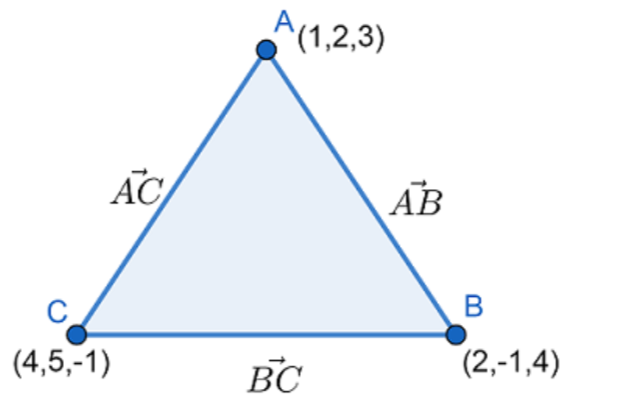
Using vectors, find the area of triangle ABC, whose vertices are $A\left( 1,2,3 \right),B\left( 2,-1,4 \right)$ and $C\left( 4,5,-1 \right)$.
Answer
572.4k+ views
Hint: First we draw a diagram of triangle ABC. Let \[\overset{\to }{\mathop{AB}}\,\] and \[\overset{\to }{\mathop{AC}}\,\] represents the side vectors so, the area of triangle is given by \[\dfrac{1}{2}\times \left| \overset{\to }{\mathop{AB}}\,\times \overset{\to }{\mathop{AC}}\, \right|\] . We use the cross product of vectors to calculate the value of \[\left| \overset{\to }{\mathop{AB}}\,\times \overset{\to }{\mathop{AC}}\, \right|\]. To find the length of \[\overset{\to }{\mathop{AB}}\,\] and \[\overset{\to }{\mathop{AC}}\,\], we use the distance formula as coordinates of vertices are given in the question.
Complete step-by-step solution:
We have been given that the vertices of $\Delta ABC$ are $A\left( 1,2,3 \right),B\left( 2,-1,4 \right)$ and $C\left( 4,5,-1 \right)$.
We have to find the area of the triangle.
Let us first draw a diagram of $\Delta ABC$ with vertices $A\left( 1,2,3 \right),B\left( 2,-1,4 \right)$ and $C\left( 4,5,-1 \right)$.

In $\Delta ABC$ let \[\overset{\to }{\mathop{AB}}\,\] and \[\overset{\to }{\mathop{AC}}\,\] represents the side vectors, so the area of triangle $\Delta ABC$ will be \[\dfrac{1}{2}\times \left| \overset{\to }{\mathop{AB}}\,\times \overset{\to }{\mathop{AC}}\, \right|\]
Now, first we have to calculate the length of \[\overset{\to }{\mathop{AB}}\,\] and \[\overset{\to }{\mathop{AC}}\,\].
Now, we have $A\left( 1,2,3 \right),B\left( 2,-1,4 \right)$, so the length of \[\overset{\to }{\mathop{AB}}\,=B-A\]
Thus, we have
\[\begin{align}
& \overset{\to }{\mathop{AB}}\,=\left( 2-1 \right)\overset{\wedge }{\mathop{i}}\,+\left( -1-2 \right)\overset{\wedge }{\mathop{j}}\,+\left( 4-3 \right)\overset{\wedge }{\mathop{k}}\, \\
& \overset{\to }{\mathop{AB}}\,=\overset{\wedge }{\mathop{i}}\,-3\overset{\wedge }{\mathop{j}}\,+\overset{\wedge }{\mathop{k}}\, \\
\end{align}\]
Now, we have \[A\left( 1,2,3 \right)\] and $C\left( 4,5,-1 \right)$, so the length of \[\overset{\to }{\mathop{AC}}\,=C-A\]
Thus, we have
\[\begin{align}
& \overset{\to }{\mathop{AC}}\,=\left( 4-1 \right)\overset{\wedge }{\mathop{i}}\,+\left( 5-2 \right)\overset{\wedge }{\mathop{j}}\,+\left( -1-3 \right)\overset{\wedge }{\mathop{k}}\, \\
& \overset{\to }{\mathop{AC}}\,=\overset{\wedge }{\mathop{3i}}\,+3\overset{\wedge }{\mathop{j}}\,-4\overset{\wedge }{\mathop{k}}\, \\
\end{align}\]
Now, we have to find the cross product of \[\left| \overset{\to }{\mathop{AB}}\,\times \overset{\to }{\mathop{AC}}\, \right|\]
So, we have \[\overset{\to }{\mathop{AB}}\,\times \overset{\to }{\mathop{AC}}\,=\left( \overset{\wedge }{\mathop{i}}\,-3\overset{\wedge }{\mathop{j}}\,+\overset{\wedge }{\mathop{k}}\, \right)\times \left( 3\overset{\wedge }{\mathop{i}}\,+3\overset{\wedge }{\mathop{j}}\,-4\overset{\wedge }{\mathop{k}}\, \right)\]
Now, we know that
\[\begin{align}
& \overset{\wedge }{\mathop{i}}\,\times \overset{\wedge }{\mathop{i}}\,=0,\overset{\wedge }{\mathop{j}}\,\times \overset{\wedge }{\mathop{j}}\,=0,\overset{\wedge }{\mathop{k}}\,\times \overset{\wedge }{\mathop{k}}\,=0, \\
& \overset{\wedge }{\mathop{i}}\,\times \overset{\wedge }{\mathop{j}}\,=\overset{\wedge }{\mathop{k}}\,,\overset{\wedge }{\mathop{i}}\,\times \overset{\wedge }{\mathop{k}}\,=-\overset{\wedge }{\mathop{j}}\,,\overset{\wedge }{\mathop{j}}\,\times \overset{\wedge }{\mathop{k}}\,=\overset{\wedge }{\mathop{i}}\, \\
\end{align}\]
Now, solving further we get
\[\overset{\to }{\mathop{AB}}\,\times \overset{\to }{\mathop{AC}}\,=\left( 12-3 \right)\overset{\wedge }{\mathop{i}}\,-\left( -4-3 \right)\overset{\wedge }{\mathop{j}}\,+\left( 3+9 \right)\overset{\wedge }{\mathop{k}}\,\]
\[\Rightarrow \overset{\to }{\mathop{AB}}\,\times \overset{\to }{\mathop{AC}}\,=9\overset{\wedge }{\mathop{i}}\,+7\overset{\wedge }{\mathop{j}}\,+12\overset{\wedge }{\mathop{k}}\,\]
Now the value of \[\left| \overset{\to }{\mathop{AB}}\,\times \overset{\to }{\mathop{AC}}\, \right|\] will be $\sqrt{{{9}^{2}}+{{7}^{2}}+{{12}^{2}}}=\sqrt{274}$
So, the area of triangle will be \[\dfrac{1}{2}\times \left| \overset{\to }{\mathop{AB}}\,\times \overset{\to }{\mathop{AC}}\, \right|=\dfrac{1}{2}\times \sqrt{274}\]
$\Rightarrow \dfrac{\sqrt{274}}{2}sq.units$
So, the area of triangle $\Delta ABC$ is $\dfrac{\sqrt{274}}{2}sq.units$.
Note: The area of triangle cannot be negative so we take modulus while applying the formula. The possibility of mistake is while calculating the lengths of \[\overset{\to }{\mathop{AB}}\,\] and \[\overset{\to }{\mathop{AC}}\,\]. As we use vectors so the value of \[\overset{\to }{\mathop{AB}}\,=B-A\] is the correct way to calculate, so do not take as \[\overset{\to }{\mathop{AB}}\,=A-B\], it gives the incorrect answer.
Complete step-by-step solution:
We have been given that the vertices of $\Delta ABC$ are $A\left( 1,2,3 \right),B\left( 2,-1,4 \right)$ and $C\left( 4,5,-1 \right)$.
We have to find the area of the triangle.
Let us first draw a diagram of $\Delta ABC$ with vertices $A\left( 1,2,3 \right),B\left( 2,-1,4 \right)$ and $C\left( 4,5,-1 \right)$.

In $\Delta ABC$ let \[\overset{\to }{\mathop{AB}}\,\] and \[\overset{\to }{\mathop{AC}}\,\] represents the side vectors, so the area of triangle $\Delta ABC$ will be \[\dfrac{1}{2}\times \left| \overset{\to }{\mathop{AB}}\,\times \overset{\to }{\mathop{AC}}\, \right|\]
Now, first we have to calculate the length of \[\overset{\to }{\mathop{AB}}\,\] and \[\overset{\to }{\mathop{AC}}\,\].
Now, we have $A\left( 1,2,3 \right),B\left( 2,-1,4 \right)$, so the length of \[\overset{\to }{\mathop{AB}}\,=B-A\]
Thus, we have
\[\begin{align}
& \overset{\to }{\mathop{AB}}\,=\left( 2-1 \right)\overset{\wedge }{\mathop{i}}\,+\left( -1-2 \right)\overset{\wedge }{\mathop{j}}\,+\left( 4-3 \right)\overset{\wedge }{\mathop{k}}\, \\
& \overset{\to }{\mathop{AB}}\,=\overset{\wedge }{\mathop{i}}\,-3\overset{\wedge }{\mathop{j}}\,+\overset{\wedge }{\mathop{k}}\, \\
\end{align}\]
Now, we have \[A\left( 1,2,3 \right)\] and $C\left( 4,5,-1 \right)$, so the length of \[\overset{\to }{\mathop{AC}}\,=C-A\]
Thus, we have
\[\begin{align}
& \overset{\to }{\mathop{AC}}\,=\left( 4-1 \right)\overset{\wedge }{\mathop{i}}\,+\left( 5-2 \right)\overset{\wedge }{\mathop{j}}\,+\left( -1-3 \right)\overset{\wedge }{\mathop{k}}\, \\
& \overset{\to }{\mathop{AC}}\,=\overset{\wedge }{\mathop{3i}}\,+3\overset{\wedge }{\mathop{j}}\,-4\overset{\wedge }{\mathop{k}}\, \\
\end{align}\]
Now, we have to find the cross product of \[\left| \overset{\to }{\mathop{AB}}\,\times \overset{\to }{\mathop{AC}}\, \right|\]
So, we have \[\overset{\to }{\mathop{AB}}\,\times \overset{\to }{\mathop{AC}}\,=\left( \overset{\wedge }{\mathop{i}}\,-3\overset{\wedge }{\mathop{j}}\,+\overset{\wedge }{\mathop{k}}\, \right)\times \left( 3\overset{\wedge }{\mathop{i}}\,+3\overset{\wedge }{\mathop{j}}\,-4\overset{\wedge }{\mathop{k}}\, \right)\]
Now, we know that
\[\begin{align}
& \overset{\wedge }{\mathop{i}}\,\times \overset{\wedge }{\mathop{i}}\,=0,\overset{\wedge }{\mathop{j}}\,\times \overset{\wedge }{\mathop{j}}\,=0,\overset{\wedge }{\mathop{k}}\,\times \overset{\wedge }{\mathop{k}}\,=0, \\
& \overset{\wedge }{\mathop{i}}\,\times \overset{\wedge }{\mathop{j}}\,=\overset{\wedge }{\mathop{k}}\,,\overset{\wedge }{\mathop{i}}\,\times \overset{\wedge }{\mathop{k}}\,=-\overset{\wedge }{\mathop{j}}\,,\overset{\wedge }{\mathop{j}}\,\times \overset{\wedge }{\mathop{k}}\,=\overset{\wedge }{\mathop{i}}\, \\
\end{align}\]
Now, solving further we get
\[\overset{\to }{\mathop{AB}}\,\times \overset{\to }{\mathop{AC}}\,=\left( 12-3 \right)\overset{\wedge }{\mathop{i}}\,-\left( -4-3 \right)\overset{\wedge }{\mathop{j}}\,+\left( 3+9 \right)\overset{\wedge }{\mathop{k}}\,\]
\[\Rightarrow \overset{\to }{\mathop{AB}}\,\times \overset{\to }{\mathop{AC}}\,=9\overset{\wedge }{\mathop{i}}\,+7\overset{\wedge }{\mathop{j}}\,+12\overset{\wedge }{\mathop{k}}\,\]
Now the value of \[\left| \overset{\to }{\mathop{AB}}\,\times \overset{\to }{\mathop{AC}}\, \right|\] will be $\sqrt{{{9}^{2}}+{{7}^{2}}+{{12}^{2}}}=\sqrt{274}$
So, the area of triangle will be \[\dfrac{1}{2}\times \left| \overset{\to }{\mathop{AB}}\,\times \overset{\to }{\mathop{AC}}\, \right|=\dfrac{1}{2}\times \sqrt{274}\]
$\Rightarrow \dfrac{\sqrt{274}}{2}sq.units$
So, the area of triangle $\Delta ABC$ is $\dfrac{\sqrt{274}}{2}sq.units$.
Note: The area of triangle cannot be negative so we take modulus while applying the formula. The possibility of mistake is while calculating the lengths of \[\overset{\to }{\mathop{AB}}\,\] and \[\overset{\to }{\mathop{AC}}\,\]. As we use vectors so the value of \[\overset{\to }{\mathop{AB}}\,=B-A\] is the correct way to calculate, so do not take as \[\overset{\to }{\mathop{AB}}\,=A-B\], it gives the incorrect answer.
Recently Updated Pages
In cricket, what is a "pink ball" primarily used for?

In cricket, what is the "new ball" phase?

In cricket, what is a "death over"?

What is the "Powerplay" in T20 cricket?

In cricket, what is a "super over"?

In cricket, what is a "tail-ender"?

Trending doubts
Who was the first woman to receive Bharat Ratna?

Write a letter to the principal requesting him to grant class 10 english CBSE

Why is there a time difference of about 5 hours between class 10 social science CBSE

What is the median of the first 10 natural numbers class 10 maths CBSE

The Equation xxx + 2 is Satisfied when x is Equal to Class 10 Maths

Discuss the main reasons for poverty in India




